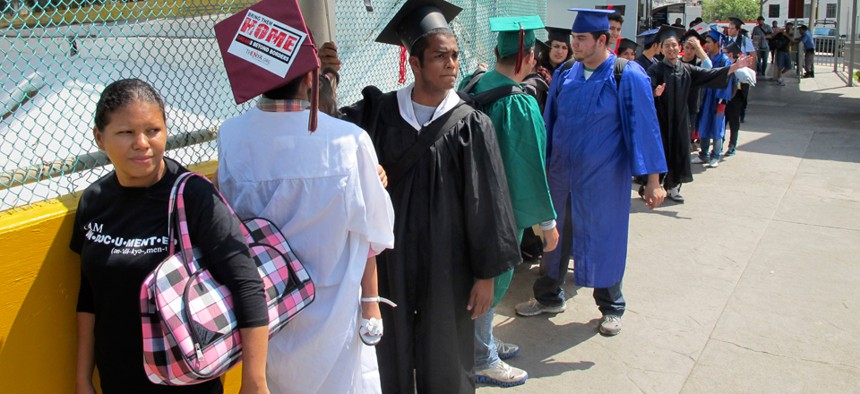
Wearing graduation-style caps and gowns, U.S.-raised immigrants wait on the Mexican side of the international bridge as they try to return to the U.S. from Nuevo Laredo, Mexico in September. Christopher Sherman/AP
The Uncontroversial Policies at the Heart of the Border Crisis
Behind the surge in unaccompanied minors at the U.S. border is a series of laws crafted over a decade.
The situation at the U.S.-Mexico border has ballooned, politically and logistically. President Obama has declared it an emergency and is asking Congress for $2 billion to handle the care, processing, and adjudication of tens of thousands of Central American unaccompanied minors who have been apprehended at the border in the last few months. This week, the Senate Appropriations Committee will hear from the secretaries of State, Health and Human Services, and the Department of Homeland Security to inquire about the president's request.
How did we get here? The influx of undocumented teens from Guatemala, El Salvador, and Honduras over the last six months cannot be definitively tied to any policy change inside the United States, although several critics have tried to make that connection. Obama's deferred-action program for undocumented young adults brought here years ago as children is almost two years old. Even though the Senate did pass a broad immigration bill last year, there was no similar surge in border crossings when it passed similar legislation in 2006. And last year's legislation, of course, died in the House.
Still, the backlog in handling the unaccompanied minors is definitely an outgrowth of generally noncontroversial policy changes over the past 10 years that have resulted in a bottleneck in processing at the border.
What's more, those changes were meant to treat border-crossing detainees humanely, responsibly, and in closer conjunction with the law.
First, a noncontroversial anti-human-trafficking law that passed Congress unanimously in 2008 made it more difficult to send undocumented unaccompanied minors back to their home countries, especially if they weren't from the countries that border the United States. Previously, all unaccompanied minors were required to be questioned by border patrol to ensure that they were not part of a trafficking ring and would willingly go home without punishment. But there wasn't an effort to locate someone who might already be in the United States to care for them.
Now there is. As a result of the 2008 law, border officials now are required to turn over unaccompanied minors to Department of Health and Human Services officials, who then make a concerted effort to find a family member or guardian inside the United States to whom the children can be released.
In other words, the federal government, by law, is in the business of reuniting children with their families. In 2008, no one thought that was a bad idea. (The same reunification process often isn't immediately available to kids who cross the border from Mexico, because Mexico has special repatriation agreements with the United States. Still, U.S. authorities are required to release those children to Mexican welfare officials.)
Many kids are now coming to the United States to meet family members, some of whom have been here for years. The Migration Policy Institute recently estimated that 85 to 90 percent of the unaccompanied minors crossing the border from Central America can be placed with a close relative or parent inside the United States. Some of those relatives are here illegally, but others are here legally under "Temporary Protected Status" visas—special accommodations granted to immigrants from countries deemed to have substantial natural disasters or ongoing armed conflicts.
Temporary Protected Status has been a longtime policy of the United States, and is also largely noncontroversial. The U.S. granted El Salvador TPS status in 2001. Honduras has had it since 1998. Adults who come to the country under this law aren't allowed to petition to bring their children here, but they can renew their own legal status as many times as they need to. If they have been here for a while, chances are the babies they left at home have grown up and now may be able to survive a journey to the United States.
Then there's the issue of the backlog. At the beginning of the Obama administration, the U.S. Customs and Border Patrol began instituting new processes to stop people who were caught from attempting to cross the border again. Under the Bush administration, captured aliens often were "voluntarily removed" to Mexico with nothing in their records but a bookkeeping reprimand, the equivalent of a parking ticket. Some border agents said they encountered the same crossers more than once during an eight-hour shift. (For a longer overview of border efforts early on in the administration, see this feature from National Journal in 2012.)
Early on, the Obama administration responded to critiques about the border-crossing recidivism with harsher penalties for illegal entrants. In Arizona, one of the busiest areas for processing undocumented immigrants, about 90 percent of those now apprehended are placed into a new and pointedly named "consequence delivery system." The program assigns ascending levels of punishment to repeat crossers.
All of this new processing takes time and money. It is more involved than simply loading up a bus and emptying it across the border a few miles away, but also arguably better in tune with the law. Children are given more attention and protections under the new human-trafficking law, which also makes sense to most people.
But to handle it all, the border patrol needs to be running like a well-oiled machine. The Tucson detention facility has an immigration judge onsite to handle the caseload. Buses come daily with new loads of people who were picked up along the border. When it works well, it's still a lot of paperwork. When there's steep rise in border crossings, as there has been over the last few months, it's easy to see how the system can get overwhelmed.






